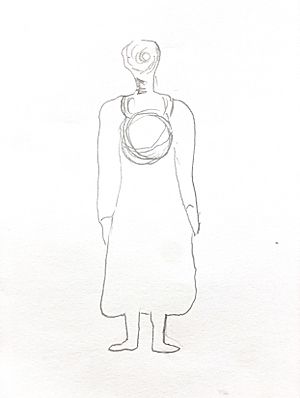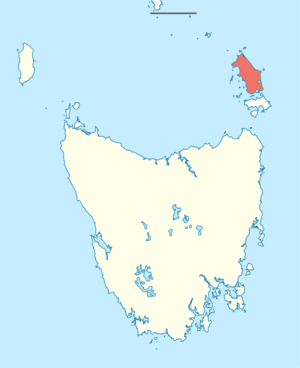Luggenemenener facts for kids
Quick facts for kids
Luggenemenener
|
|
|---|---|
 |
|
| Born | 1800s Ben Lomond
|
| Died | March 21, 1837 Flinders Island
|
| Nationality | Australian |
| Known for | Leader of Ben Lomond Tribe |
|
Notable work
|
Defending The Ben Lomond People |
Luggenemenener (born around 1800 – died March 21, 1837) was a brave Tasmanian Aboriginal woman. She lived in the early 1800s. She faced the difficult times of the Black Wars. Luggenemenener risked her life to protect her young son from harm. Her home was in the Ben Lomond area of north-east Tasmania. The French explorer Nicolas Baudin said that Tasmania was originally called Lutruwita.
Contents
Early Life and Family
Luggenemenener was a mother to three sons: Walter, Maulboyheener, and Rolepana. Rolepa, Walter's father, was a strong leader of the Ben Lomond people. The Ben Lomond Nation had about 150 to 200 people. They were the first people to live in that area.
In 1829, when a group of armed men threatened her people, Luggenemenener bravely covered her two-year-old son, Rolepana. She completely hid him and saved his life.
The Ben Lomond Conflict
From 1828 to 1830, a man named John Batman led groups called 'roving parties'. These groups aimed to remove Tasmanian Aboriginal people from their land. They wanted to settle on the land near Ben Lomond. These groups were made of people who helped in exchange for land.
John Batman's Actions
Governor George Arthur of Tasmania said Batman was responsible for many deaths. In September 1829, Batman, who was 28, attacked an Aboriginal family group. This group had 60 to 70 men, women, and children. He had brought some "Sydney blacks" to Tasmania to help him.
At night, their dogs barked, and the Aboriginal people tried to escape. Batman ordered his men to fire at them. About 15 people were killed. The next morning, he left with two badly hurt Tasmanian men, a woman, and her two-year-old son. He had captured them. The captured woman was Luggenemenener.
Capture and Hardship
After the attack on her people, Batman captured Luggenemenener and her son Rolepana. He also took two injured men. Batman wrote a letter to the police about what happened. He said he had to kill the two injured men because they could not walk.
Luggenemenener was sent to the Campbell Town jail. Her child was taken to Batman's farm. This farm, called "Kingston," was near the Ben Lomond rivulet. Batman's farm started at 500 acres in 1824. Over time, it grew to 7,000 acres.
A Brave Stand
In 1830, after almost a year in prison, Batman let Luggenemenener go. But she had to agree to a deal. She was to act as a messenger to the Ben Lomond People. Batman had been trying to find this tribe for two years. He gave her the hard job of convincing the last members of her tribe to give up to the authorities.
Luggenemenener cried as she shook Batman's hand. She promised to bring her tribe back. But she had no plan to return to jail or bring her people to Batman. She quickly found her tribe. She traveled freely until she met soldiers from the Black Line. She spent time both in and out of jail.
The Black Line
The Black Line was a plan by the colonial forces. They drew lines across the land to protect themselves from Aboriginal attacks. This happened as more settlers moved onto Aboriginal land.
About 2200 men were part of the Black Line. This included soldiers, free men, and 1,200 prisoners.
Luggenemenener later said that the soldiers stretched for a long way. They kept firing their guns. She said there were many horsemen, many soldiers, and many big fires on the hills. She was afraid they would shoot her and her people.
Fearing for their lives, Luggenemenener convinced others to follow her to Batman's farm. They arrived on October 19. They knew something big was happening. The respected chief Mannalargenna led this group. He was good at talking to people. He charmed Batman and his neighbors.
However, this friendliness might have been a trick. After getting food and protection for ten days, Mannalargenna and his group left Batman’s farm in the middle of the night. They took his dogs and supplies. The next day, they raided two huts near the South Esk River. They were chased by a group of white men. After a fight at Grants Mill, the group was surprised while taking things from a hut at Fingal. Two warriors were killed.
Thirteen days later, they reached Cape Portland. They started sending smoke signals to George Augustus Robinson. Robinson had recently set up a temporary mission on Swan Island. On November 15, a group of messengers came to take the remaining one woman and five men to the mission.
Flinders Island
From 1830, the last of Tasmania's Aboriginal people, including Luggenemenener, were sent away. They were moved to Settlement Point on Flinders Island. This place was also called Wybalenna. This means "Black Man's House" in the Ben Lomond language. About 160 survivors were thought to be safe there. But living conditions were poor. Diseases spread quickly. This plan to move them did not last long. Luggenemenener died on March 21, 1837. George Augustus Robinson, who looked after Aboriginal people on Flinders Island, called her Queen Charlotte.
The Last of the Ben Lomond People
Later, Aboriginal people protested against their leader, Henry Jeanneret. They even sent a request to Queen Victoria. Because of this, the remaining 47 Aboriginal people were moved again in 1847. This time, they went to Oyster Cove Station. This was a former convict settlement south of Hobart, Tasmania's capital. Truganini, believed to be the last full-blood Tasmanian Aboriginal person, died there in 1876.
At the end of the Black War in 1834, George Augustus Robinson and Lieutenant-Governor Arthur wanted Luggenemenener’s son, Rolepana, to go to the Aboriginal settlement on Flinders Island.
Even though the Governor approved, Batman refused to let the boy go. Robinson had a long disagreement with Batman about Rolepana. Robinson even sent his own son to Batman's farm to get the boy.
The Stolen Generations
When Batman moved to Melbourne to settle Port Phillip, Rolepana, who was then eight years old, went with him. The exact relationship between Batman and Rolepana is not clear. It is similar to the early times of the Stolen Generations. This was a period when Aboriginal children were taken from their families. Early settlers seemed to want native children. Batman refused to let Rolepana and another boy leave his service. He openly challenged the Governor and the Aboriginal Protector.
Batman claimed the boys were with him because their parents agreed. He said they were "as much his property as his farm." He believed he had the same right to keep them as the government did.
Luggenemenener's Appearance
An image based on Robinson’s sketch from October 1832 shows Luggenemenener. She is shown as a simply dressed woman with her hair pulled back. She has long, strong arms and looks very young. A special feature is a large disc on her back, like a decorative backpack.
Robinson wrote about the sadness in her life. He also noted the beauty of her community, which gave her strength. He described her wearing a "mourning" item.
Cultural Grief
Robinson wrote about how Aboriginal people showed their sadness. He described their deep feelings when a friend died. He said their sorrow was very strong.
When traditional funeral customs were followed, the sadness was less. Losing someone in a war was hard. But if the usual rituals to help the soul move on were not possible, those left behind were scared of the spirit of the dead. These rituals were very important. People tried hard to get the bodies of their fallen friends.
The ashes of the dead were collected in kangaroo skin. Every morning before sunrise, some ashes were put on the faces of those who were sad. A death song was sung with strong feelings. Tears would make clear lines through the ashes.
Legacy
Luggenemenener wore a mourning disc every day. This showed the strong way her culture expressed grief. It took patience to weave the rope pieces into a disc. The disc's weight reminded her constantly of lost loved ones and her young son.
She is remembered as a young woman who lived far from her Ben Lomond home. She was stuck on an island in Bass Strait. Her child was taken from her, and her people were killed.
The rope and fiber weaving in Tasmanian Aboriginal culture, seen in jewelry, bags, and boats, might be similar to the rope-woven mourning dress Luggenemenener wore.
See also
 In Spanish: Luggenemenener para niños
In Spanish: Luggenemenener para niños





